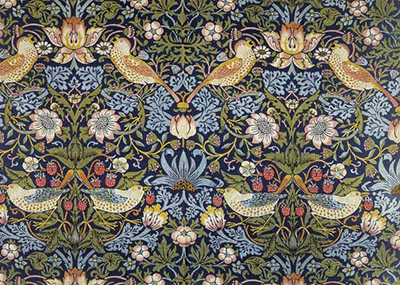Strawberry Thief represents a charming story from William Morris' life which would ultimately inspire this design. The 1883 printed cotton furnishing textile now resides within the collection of the V&A Museum in London, UK.
The title refers to a large number of thrushes who would visit his garden at around that time and rudely steal his strawberries. The eventual design was intended to be used as curtains or drapes and was one of the more expensive options to be found at Morris & Co. Despite this pricing, it would actually prove to be one of their most popular designs and remains highly regarded today. Indeed, the V&A afford Strawberry Thief some considerable exposure witin their large Morris collection, as its popularity remains just as strong today. This complex pattern could the designer several attempts before he could print it to a satisfactory level and his methods were normally time consuming because of his insistence of using traditional techniques. The initial design was constructed in the 1870s but it was not until 1883 that a successful printing of it was complete, and the patent registered. A careful study of the design reveals the birds poised and ready to act, with four included as two pairs. They would be placed in opposing forms which best suited patterned designs in which they would be repeated many times over.
Tones of blue and green dominate this design, along with the lighter tones of the thrushes which stand out beautifully. With the centre of the textile design, in the lower half, we can see an array of strawberries which relate to the treasure found within the artist's garden at Kelmscott Manor in Oxfordshire. For Morris to try several times to produce this design, the first of which would fail, underlines how he liked this patterned look and very much wanted to get over the initial technical problems that he experienced. As mentioned, the method that eventually worked was traditional and time consuming, hence its relatively high price once Strawberry Thief came up for sale. Some regard it as his most famous design of all, which is quite a claim considering the high levels of quality that he sustained right across his career, as well as the considerable output that he, and the companies in which he was involved, would produce over the length of his career.
Several versions of the original design exist today, spread right across the world. Morris would spend several times working on each production of this design, making it quite a challenge. The original design can now be found reproduced by all manner of different companies in alternative formats such as wallpaper for the many Morris followers to be found in the present day. It was originally intended to be hung within one's home, or perhaps used instead a cover for items of furniture. Morris himself had a very clear signature style that could actually be stretched and adapeted across a variety of different products, which helped his businesses to remain profitable by offering a wide selection of items to retailers and consumers. Today the content is seen as charming and traditional, where old techniques were used and quality was afforded a greater importance over profitability.




